Jasper Lake Fanless Showdown: ECS LIVA Z3 and ZOTAC ZBOX CI331 nano UCFF PCs Review
by Ganesh T S on July 8, 2022 8:30 AM EST- Posted in
- Systems
- ZOTAC
- Fanless
- ECS
- Passive Cooling
- UCFF
- Mini-PC
- Jasper Lake
GPU Performance
In moving from Gemini Lake to Jasper Lake, the integrated GPU didn't get as much attention as the CPU did. While retaining the same microarchitecture, the shift to 10nm allowed for integrating more execution units and slight improvements in the maximum clocks. The systems we are looking at today come with different variants of the same GPU microarchitecture:
- Intel June Canyon and ECS LIVA Z2 (Gemini Lake): 18EU @ 750 MHz
- ECS LIVA Z3 / JSLM-MINI (Jasper Lake): 32EU @ 850 MHz
- ZOTAC ZBOX CI331 nano (Jasper Lake): 24EU @ 850 MHz
Based on these specifications alone, we expect the JSLM-MINI / LIVA Z3 to handily best the other systems in GPU performance. However, there are a few caveats to consider:
- Power budget / PL1 limit is higher for the ZBOX CI331 nano compared to the JSLM-MINI
- The June Canyon NUC is actively cooled and is not affected by thermal throttling
- The LIVA Z3 and JSLM-MINI operate with DDR4-2666 SODIMMs, while the ZBOX operates with DDR4-2933 SODIMMs
Keeping these aspects in mind, the GPU performance has to be evaluated in the context of each workload. We put the systems through some standard 3D workloads to get an idea of what they have to offer for GPU-intensive tasks.
GFXBench
The DirectX 12-based GFXBench tests from Kishonti are cross-platform, and available all the way down to smartphones. As such, they are not very taxing for discrete GPUs and modern integrated GPUs. We processed the offscreen versions of the 'Aztec Ruins' benchmark.
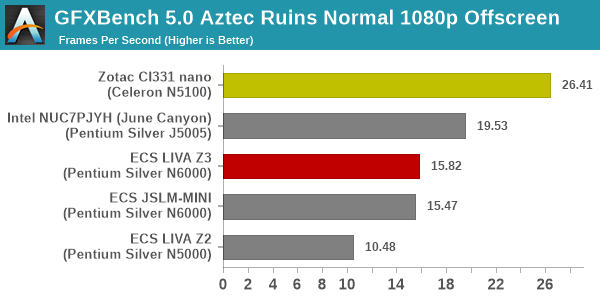
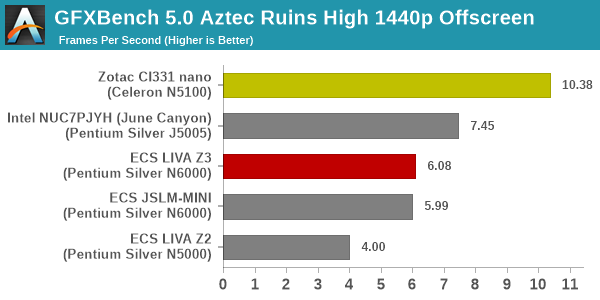
The ZBOX CI331 nano's iGPU has extra EUs compared to the June Canyon NUC. It also has faster RAM access. Though the number of EUs is lesser than the iGPU's in the LIVA Z3 / JSLM-MINI, the higher PL1 limit and faster RAM access help the ZBOX to emerge as the leader in both GFXBench workloads.
UL 3DMark
Four different workload sets were processed in 3DMark - Fire Strike, Time Spy, Night Raid, and Wild Life.
3DMark Fire Strike
The Fire Strike benchmark has three workloads. The base version is meant for high-performance gaming PCs. It uses DirectX 11 (feature level 11) to render frames at 1920 x 1080. The Extreme version targets 1440p gaming requirements, while the Ultra version targets 4K gaming system, and renders at 3840 x 2160. The graph below presents the overall score for the Fire Strike Extreme and Fire Strike Ultra benchmark across all the systems that are being compared.
| UL 3DMark - Fire Strike Workloads | |||
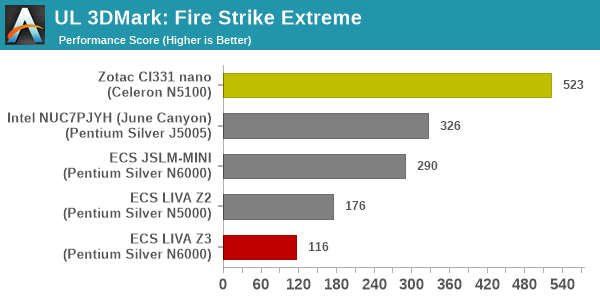
The Extreme workload sees the CI331 nano come out comfortably on top for the same reasons as the ones discussed in the GFXBench subsection - the higher PL1 limits, extra EUs compared to June Canyon, and faster DRAM. The Ultra workload (which doesn't make much sense for UCFF PCs based on low-power processors like Jasper Lake anyway) sees both the LIVA Z3 and the ZBOX CI331 nano get timed out - in all probability due to thermal throttling.
3DMark Time Spy
The Time Spy workload has two levels with different complexities. Both use DirectX 12 (feature level 11). However, the plain version targets high-performance gaming PCs with a 2560 x 1440 render resolution, while the Extreme version renders at 3840 x 2160 resolution. The graphs below present both numbers for all the systems that are being compared in this review.
| UL 3DMark - Time Spy Workloads | |||
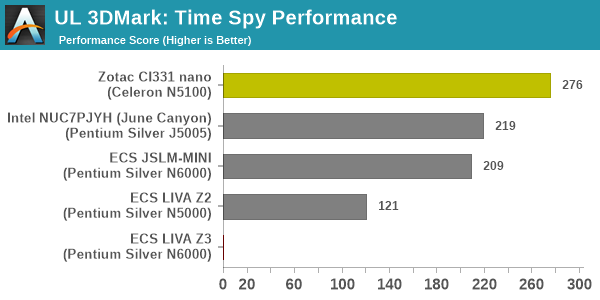
The LIVA Z3 is thermally limited to the extent that neither Time Spy workload completes. The extra EUs and faster RAM help the ZBOX in the normal Time Spy workload. However, at higher resolutions (Extreme), the ZBOX gets thermally limited and its lowered power budget is insufficient to see it get past the June Canyon and JSLM-MINI.
3DMark Wild Life
The Wild Life workload was initially introduced as a cross-platform GPU benchmark in 2020. It renders at a 2560 x 1440 resolution using Vulkan 1.1 APIs on Windows. It is a relatively short-running test, reflective of mobile GPU usage. In mid-2021, UL released the Wild Life Extreme workload that was a more demanding version that renders at 3840 x 2160 and runs for a much longer duration reflective of typical desktop gaming usage.
| UL 3DMark - Wild Life Workloads | |||
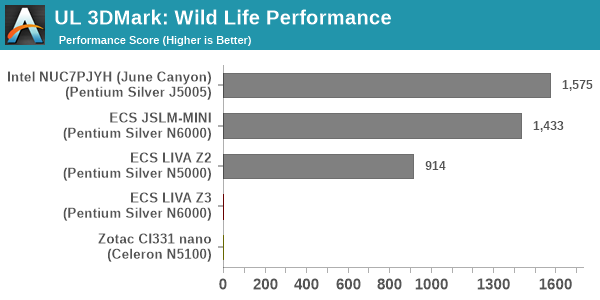
The Wild Life workload was again a mixed bag for the ZBOX, with thermal behavior causing timeouts. The LIVA Z3 failed in both components. Active cooling and a consistent power budget actually see the Gemini Lake-based June Canyon NUC on the leaderboard this time.
3DMark Night Raid
The Night Raid workload is a DirectX 12 benchmark test. It is less demanding than Time Spy, and is optimized for integrated graphics. The graph below presents the overall score in this workload for different system configurations.
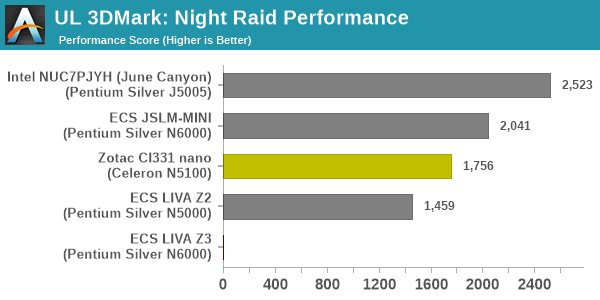
Power budget seems to be the primary factor for the Night Raid workload. The June Canyon NUC is at the top despite its limited EUs and slower RAM. The JSLM-MINI is able to sustain a 6W PL1 for extended durations, and coupled with the extra EUs over the CI331 nano, it handily bests the ZBOX in this workload.










52 Comments
View All Comments
mode_13h - Saturday, July 9, 2022 - link
> tldr both benches would have been a wash one way of the other.Huh? If old Skylake is 50% faster, and Jasper Lake is 3.5x as fast as Pi 4 Model B (which seems rather generous), then it wouldn't be "a wash", which is defined as:
13. an action or situation in which the gains and losses are
equal, or closely compensate each other.
(source: http://dict.org/bin/Dict?Form=Dict2&Database=g... )
or
8: any enterprise in which losses and gains cancel out; "at the
end of the year the accounting department showed that it was
a wash"
(source: http://dict.org/bin/Dict?Form=Dict2&Database=w... )
Since both comparisons are projected to be substantially lopsided, I think what you meant to call it is a "washout"?
abufrejoval - Thursday, July 14, 2022 - link
I have a PI4 with 8GB of RAM in a metal case that supports a 2GHz overclock without active cooling: pretty much the best PI you can have these days.I also have an Nvidia Tegra based Jetson Nano with 4GB of RAM.
At 2GHz the PI reaches 272/648 on Geekbench 4, the Tegra has to make do with 206/718 at 1.4GHz. The N6005 Jasper Lake reaches 781/2540 very similar to a Sandy Bridge i7-2600 at 3.8GHz Turbo.
The Jetson Nano actually does reasonably well on my 43" 4k desktop for basic 2D work, because it has a GPU with 128 Maxwell cores. Of course its CPU power is at the level of a Snapdragon 800 mobile phone.
The PI struggles badly at 4k, because the GPU has much less muscle. The slightly faster CPU is hard to notice.
Actually it was when Tom's hardware did a report on a PI compute cluster, that I wanted to retort just how stupid that project was, because you could get a single Jasper Lake Atoms for much less money, that would run rings around that cluster and could in fact simulate it all in software via VMs.
And that's when I found that finally a Jasper Lake NUC was available for purchase at €200 (including VAT) and immediately ordered one of the first and last ever sold here.
And yes, it runs rings around both with roughly 4x the CPU power, 64GB of RAM expandability and quite a reasonable GPU performance on a 4k display.
My favorite usability test is to use the "3D Globe View" on Google Maps under a Chrome based browser on Windows and to then tilt and turn a city landscape there. It's about the most efficient 3D graphics pipeline I've ever seen (puts Flight Simulator to total shame!) and performs quite reasonable on such a Jasper Lake NUC. With Firefox it's much worse on these low power devices, but with a beefy PC you'd never notice.
After quite a bit of tweaking I managed to get it to work on both the PI and the Tegra at 1920x1080 and the Tegra even gave a bit of interactivity thanks to its much stronger GPU. But on the PI that was about one frame a minute.
The PI and Nano are toys and ok for the €100 I spent on each.
A Jasper Lake NUC is quite a reasonable desktop machine and even an interesting micro server for some real workloads.
At €200 (without RAM or storage) the price/performance ratio is very hard to beat, but evidently none of the vendors really want you to know or buy that. I think it's the major reason you never could.
mode_13h - Thursday, July 14, 2022 - link
> At 2GHz the PI reaches 272/648 on Geekbench 4, the Tegra ... 206/718 at 1.4GHz.Keep in mind that Jetson Nano has ostensibly 2x the memory bandwidth of the Pi v4. That surely helps offset the difference in raw CPU performance, as well as with 4k display performance.
Oh, and if that test was with the machines driving a 4k display, then merely refreshing your monitor will have been using a non-insignificant amount of the Pi's memory bandwidth (about 1 GB/s).
> N6005 Jasper Lake reaches 781/2540
Wow! Dual-channel memory configuration, I presume?
> on the PI that was about one frame a minute.
Uh... that sure sounds like you were using a software rendering path. The Pi's GPU is trash, but that's simply atrocious!
> evidently none of the vendors really want you to know or buy that.
> I think it's the major reason you never could.
I'm reasonably confident it's actually just supply chain-related. Intel has been steering its limited fab capacity towards more profitable models and probably steering its limited supply of Jasper Lakes to chromebooks, where they're probably desperate not to lose market share.
timecop1818 - Friday, July 8, 2022 - link
There are Chinese mini PCs withIntel Celeron N5100 that are like 250$ with 16G ram and 256gb sata SSD.
https://www.lazada.com.my/products/walkfish-m6-11t...
there's like 5 different "brands" selling same thing on AliExpress etc. it runs win 10 just fine and is enough for 1080p Minecraft and basic office computing. great deal. most models have Intel 2.5G Ethernet too.
Jorgp2 - Friday, July 8, 2022 - link
I just want a Jasper lake motherboard with plenty of sata and a PCI-E slotmode_13h - Friday, July 8, 2022 - link
You could get SATA, but not PCIe. According to this, Jasper Lake and Elkhart Lake have only x8 PCIe 3.0 and x2 SATA ports.Most boards are probably going to give you a x4 NVMe slot. Then, they could use a 3rd Party SATA controller to give you 4 more ports. Then, if they compromise on the bandwidth to that SATA controller, you can have a second Ethernet port and then a x1 PCIe slot that just might be open-ended (but probably not), to support a graphics card.
Sorry, but they really kneecapped this platform relative to what it could've been. You might do better with some equivalent Atom-branded CPUs. Atom C-series (Parker Ridge) has 16 integrated SATA ports, x32 PCIe 3.0 lanes, and up to 8 cores. P-series (Snow Ridge) has the same, but up to 24 cores.
* https://ark.intel.com/content/www/us/en/ark/produc...
* https://ark.intel.com/content/www/us/en/ark/produc...
mode_13h - Friday, July 8, 2022 - link
Oops, forgot the link for Jasper Lake. For good measure, here's Elkhart Lake, as well.* https://ark.intel.com/content/www/us/en/ark/produc...
* https://ark.intel.com/content/www/us/en/ark/produc...
Thala - Friday, July 8, 2022 - link
Interestingly my 3 years old Surface Pro X scores higher than any of the tested devices in Cinebench R23 under x64 emulation!mode_13h - Saturday, July 9, 2022 - link
The Surface Pro X from 2019 has a Microsoft SQ1 SoC, which is basically a Snapdragon 8cx and consists of 4x Kryo 495 Gold @ 3 GHz+ 4x Kryo 495 Silver @ 1.80 GHz (manufactured on TSMC 7 nm). According to wikichip, these are tweaked A76 and A55 cores. So, that seems credible, if not exactly an outcome I'd have presumed.Something to keep in mind is that Jasper Lake is meant cheap chromebooks. Like, sub-$200 cheap, whereas Snapdragon 8cx is a premium part.
nandnandnand - Saturday, July 9, 2022 - link
They wanted it to be thought of as premium, it's more of an expensive joke. Like Lakefield but with no excuses.https://semiaccurate.com/2021/12/01/qualcomm-8cx-g...
https://www.gizchina.com/2022/01/04/qualcomm-blame...
Snapdragon 7c (Gen 1?) should be more comparable in price to Jasper Lake. I think I've seen that as low as $170-200. Also, the Apcsilmic Dot 1 and ECS LIVA Mini Box QC710 mini PCs recently launched with the 7c starting at around $219.
If the leaks about Alder Lake-N are true, it will shake things up, if the price is right.